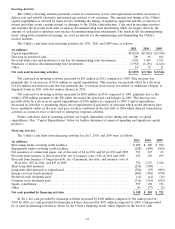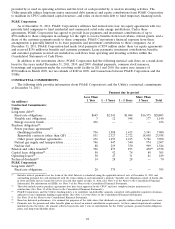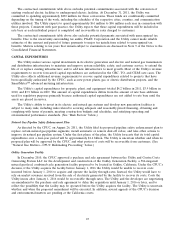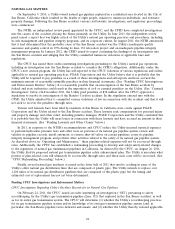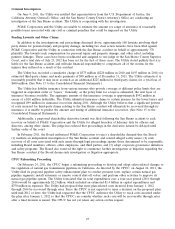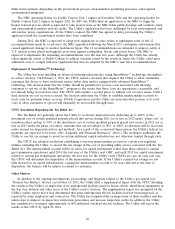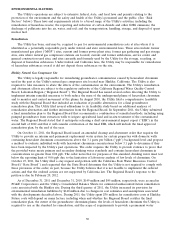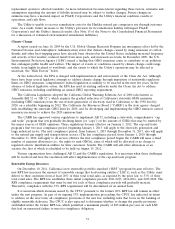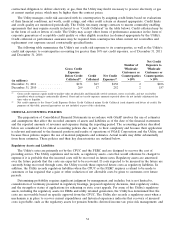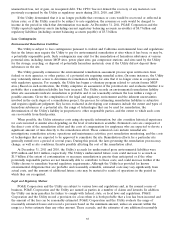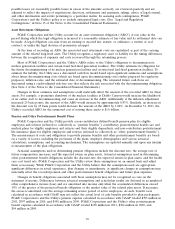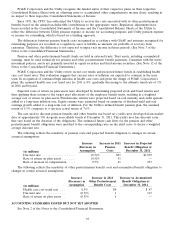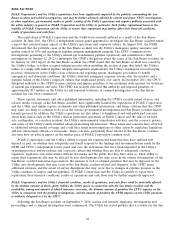PG&E 2011 Annual Report Download - page 35
Download and view the complete annual report
Please find page 35 of the 2011 PG&E annual report below. You can navigate through the pages in the report by either clicking on the pages listed below, or by using the keyword search tool below to find specific information within the annual report.replacement system to affected residents. As more information becomes known regarding these factors, estimates and
assumptions regarding the amount of liability incurred may be subject to further changes. Future changes in
estimates may have a material impact on PG&E Corporation’s and the Utility’s financial condition, results of
operations, and cash flows.
The Utility is unable to recover remediation costs for the Hinkley natural gas compressor site through customer
rates. As a result, future increases to the Utility’s provision for its remediation liability will impact PG&E
Corporation’s and the Utility’s financial results. (See Note 15 of the Notes to the Consolidated Financial Statements
for a discussion of estimated environmental remediation liabilities.)
Climate Change
A report issued on June 16, 2009 by the U.S. Global Change Research Program (an interagency effort led by the
National Oceanic and Atmospheric Administration) states that climate changes caused by rising emissions of carbon
dioxide and other heat-trapping gases have already been observed in the United States, including increased frequency
and severity of hot weather, reduced runoff from snow pack, and increased sea levels. In December 2009, the U.S.
Environmental Protection Agency (‘‘EPA’’) issued a finding that GHG emissions cause or contribute to air pollution
that endangers public health and welfare. The impact of events or conditions caused by climate change could range
widely, from highly localized to worldwide, and the extent to which the Utility’s operations may be affected is
uncertain. See ‘‘Risk Factors’’ below.
At the federal level, the EPA is charged with implementation and enforcement of the Clean Air Act. Although
there have been several legislative attempts to address climate change through imposition of nationwide regulatory
limits on GHG emissions, comprehensive federal legislation is unlikely to be enacted in the next few years. In the
absence of federal legislative action, the EPA has used its existing authority under the Clean Air Act to address
GHG emissions, including establishing an annual GHG reporting requirement.
The California Legislature adopted the California Global Warming Solutions Act of 2006 (also known as
Assembly Bill 32 or ‘‘AB 32’’), which requires the gradual reduction of California’s statewide GHG emissions
(including GHG emissions from the out-of-state generation of electricity used in California) to the 1990 level by
2020, on a schedule beginning in 2012. The California Air Resources Board (‘‘CARB’’) is the state agency charged
with establishing the statewide GHG limit for 2020, and for developing and implementing the GHG emission control
measures necessary to achieve the 2020 emissions limit.
The CARB has approved various regulations to implement AB 32, including a state-wide, comprehensive ‘‘cap
and trade’’ program that sets gradually declining limits (or ‘‘caps’’) on the amount of GHGs that may be emitted by
the major sources of GHG emissions. These regulations became effective on January 1, 2012. The cap and trade
program’s first two-year compliance period, beginning January 1, 2013, will apply to the electricity generation and
large industrial sector. The next compliance period, from January 1, 2015 through December 31, 2017, also will apply
to the natural gas supply and transportation sectors. (The last compliance period, from January 1, 2018 through
December 31, 2020, will apply to all sectors.) Before the first compliance period begins the CARB will issue a fixed
number of emission allowances (i.e., the rights to emit GHGs), some of which will be allocated at no charge to
regulated electric distribution utilities for their customers’ benefit. The CARB will sell other allowances at an
auction, the first of which is scheduled to be held on August 15, 2012.
Various organizations have challenged AB 32 and the CARB’s regulations. It is uncertain when these challenges
will be resolved and how the resolution will affect implementation of the cap-and-trade program.
Renewable Energy Resources
On December 10, 2011, California’s new renewable portfolio standard (‘‘RPS’’) program became effective. The
new RPS law increases the amount of renewable energy that load-serving entities (‘‘LSE’’s), such as the Utility, must
deliver to their customers from at least 20% of their total retail sales, as required by the prior law, to 33% of their
total retail sales. The RPS law establishes three initial compliance periods: 2011-2013, 2014-2016, and 2017-2020. The
RPS compliance requirement that must be met for each of these compliance periods will gradually increase.
Thereafter, compliance with the 33% RPS requirement will be determined on an annual basis.
It is uncertain which decisions issued by the CPUC pursuant to the former 20% RPS law will remain in effect
under the new program. As part of its ongoing 33% implementation proceeding, the CPUC has indicated its intent
to address, in the near term, all compliance provisions of the new law, including rules that focus on the banking of
eligible renewable deliveries. The CPUC is also expected to determine whether to change the penalty provisions
established under the former RPS law, which permitted a maximum penalty of $25 million per year on each LSE
that had an unexcused failure to meet its compliance obligation.
31


